Algorithmic trading platforms have evolved significantly by 2025, offering tools for retail and professional traders. Choosing the right platform depends on your trading goals, programming skills, and preferred asset classes. Here’s a quick summary:
- Key Features to Look For: Execution speed, backtesting tools, programming language support, and VPS compatibility for uninterrupted trading.
- Popular Platforms:
- NinjaTrader: Best for futures trading with C# support and no-code tools.
- MetaTrader 4/5: Forex-focused with MQL programming and free access.
- TradeStation: Advanced tools for stocks, options, and futures with EasyLanguage.
- QuantConnect: Cloud-based, supporting Python and C# for multi-asset trading.
- cTrader Automate: Forex and CFD trading with C# support.
- QuantRocket: Ideal for Interactive Brokers users with Python and C#.
These platforms cater to diverse needs, from beginners using no-code tools to experts requiring advanced customization. Whether you’re trading forex, futures, stocks, or cryptocurrencies, there’s a platform tailored for you. Below is a quick comparison to help you decide.
Choosing Best Algo Trading Platform
Quick Comparison
| Platform | Programming Language | Asset Classes | VPS Compatible | Pricing Structure |
|---|---|---|---|---|
| NinjaTrader | C# (NinjaScript) | Futures, Forex, Stocks | Yes | Free/$50-$1,099 |
| MetaTrader 4/5 | MQL4/MQL5 | Forex, Stocks, CFDs | Yes | Free |
| TradeStation | EasyLanguage | Stocks, Futures, Options | Yes | $99/month |
| QuantConnect | Python, C# | Multi-asset | Cloud-based | Free/Subscription |
| cTrader Automate | C# | Forex, CFDs | Yes | Broker-dependent |
| QuantRocket | Python, C# | Multi-asset | Yes | Custom pricing |
Each platform offers unique strengths, so start with one that aligns with your trading style and skills.
1. NinjaTrader

NinjaTrader is a powerful platform designed for futures traders seeking a mix of automation and advanced charting tools. It’s built around its proprietary NinjaScript framework, which is based on C#, and caters to both experienced developers and traders who prefer a visual, no-code method to create automated strategies.
Programming Language Support
NinjaTrader’s NinjaScript, built on C#, provides direct access to account details, orders, and real-time market data, making it possible to create custom indicators and sophisticated trading logic. For those who prefer a simpler approach, the platform includes a point-and-click tool for no-code strategy building. Additional tools like the Strategy Analyzer and Market Replay allow traders to backtest and refine strategies thoroughly before putting them into action.
Primary Asset Classes Supported
The platform supports trading in stocks, forex, futures, and cryptocurrencies. However, it’s particularly well-regarded for futures trading, thanks to its low commission rates and excellent charting capabilities.
Pricing Structure
NinjaTrader offers free charting and analysis tools, but full automation features require a paid plan. You can choose between a lifetime license starting at $1,099 or a $50 monthly subscription. Customer support is available through email, chat, and phone.
VPS Compatibility
For traders needing uninterrupted execution, NinjaTrader is fully compatible with Windows-based VPS environments, ensuring consistent, around-the-clock performance.
2. MetaTrader 4/5
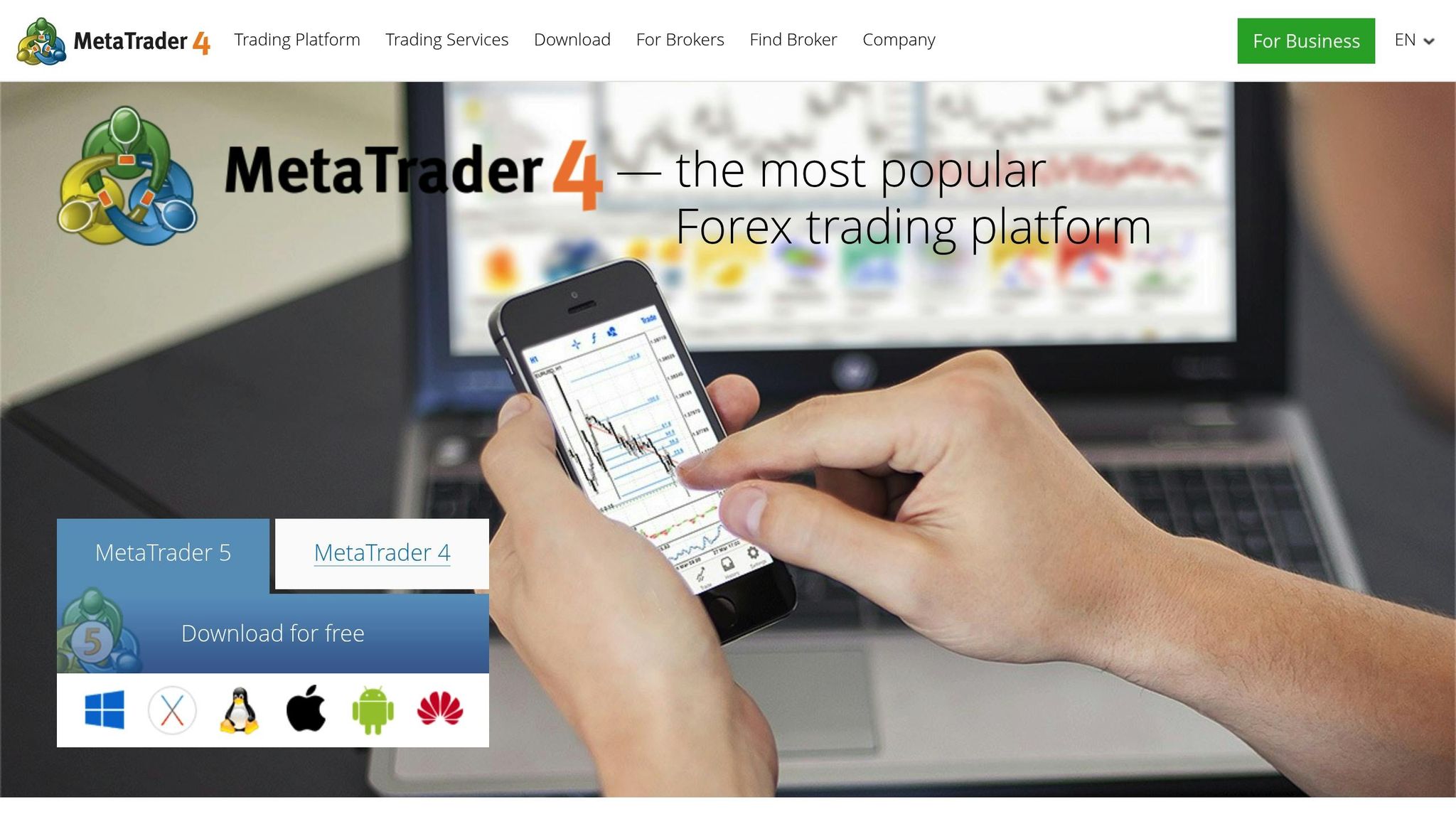
MetaTrader 4 and 5 are among the most widely used platforms in forex trading. They’ve earned their reputation for being straightforward, dependable, and packed with a rich ecosystem of automated trading tools. Plus, a massive community of developers has contributed to a vast library of pre-built Expert Advisors (EAs), making these platforms even more appealing.
Programming Language Support
MetaTrader platforms rely on their own MQL programming language for creating custom algorithms and Expert Advisors. MT4 is built around MQL4, while MT5 uses the more advanced MQL5. These languages allow traders to automate intricate strategies and test them against historical data. While MQL is tailored specifically for trading, its user-friendly design makes strategy automation within reach for many. This simplicity has played a big role in MetaTrader’s global success.
Primary Asset Classes Supported
MetaTrader supports a diverse range of asset classes, including forex, stocks, futures, and cryptocurrencies. It’s particularly dominant in the forex market, where many brokers offer seamless MetaTrader integration. With advanced charting tools and highly customizable indicators, the platform is especially effective for analyzing currency pairs.
Pricing Structure
One of the standout features of MetaTrader is that it’s completely free to use. Both MT4 and MT5 provide access to automated trading, backtesting capabilities, and a wide array of technical indicators – all without any additional cost.
3. TradeStation
TradeStation is a go-to platform for seasoned traders who need advanced tools for analytics and automation. It’s packed with professional-grade features and offers direct brokerage execution, cutting out routing delays for faster trades.
Programming Language Support
At the heart of TradeStation is EasyLanguage, a proprietary scripting tool designed for creating custom trading strategies. For those with more technical expertise, the platform also supports API connectivity with .NET and C++, giving developers the freedom to craft sophisticated algorithmic strategies. One standout feature is walk-forward optimization, which helps traders test and validate strategies across various market conditions. This level of customization makes it a versatile option for traders with diverse needs.
Primary Asset Classes Supported
TradeStation offers access to a wide range of markets, including stocks, options, futures, forex, ETFs, and cryptocurrency. Its RadarScreen feature takes real-time market scanning to the next level, allowing traders to track multiple securities or futures contracts at once. This tool is especially handy for systematic traders looking to spot new opportunities as they arise.
Pricing Structure
TradeStation operates on a subscription model, starting at $99 per month. However, fees can increase if traders don’t meet certain account balance or activity requirements. While the cost might seem steep, the platform’s robust backtesting tools, optimization features, and direct execution capabilities make it well worth the investment for serious traders.
VPS Compatibility and Technical Requirements
Running complex backtests or high-frequency trading strategies can demand significant computing power. Many traders opt for VPS hosting to ensure smooth performance and reliable uptime, especially when dealing with resource-heavy tasks.
4. Quantower
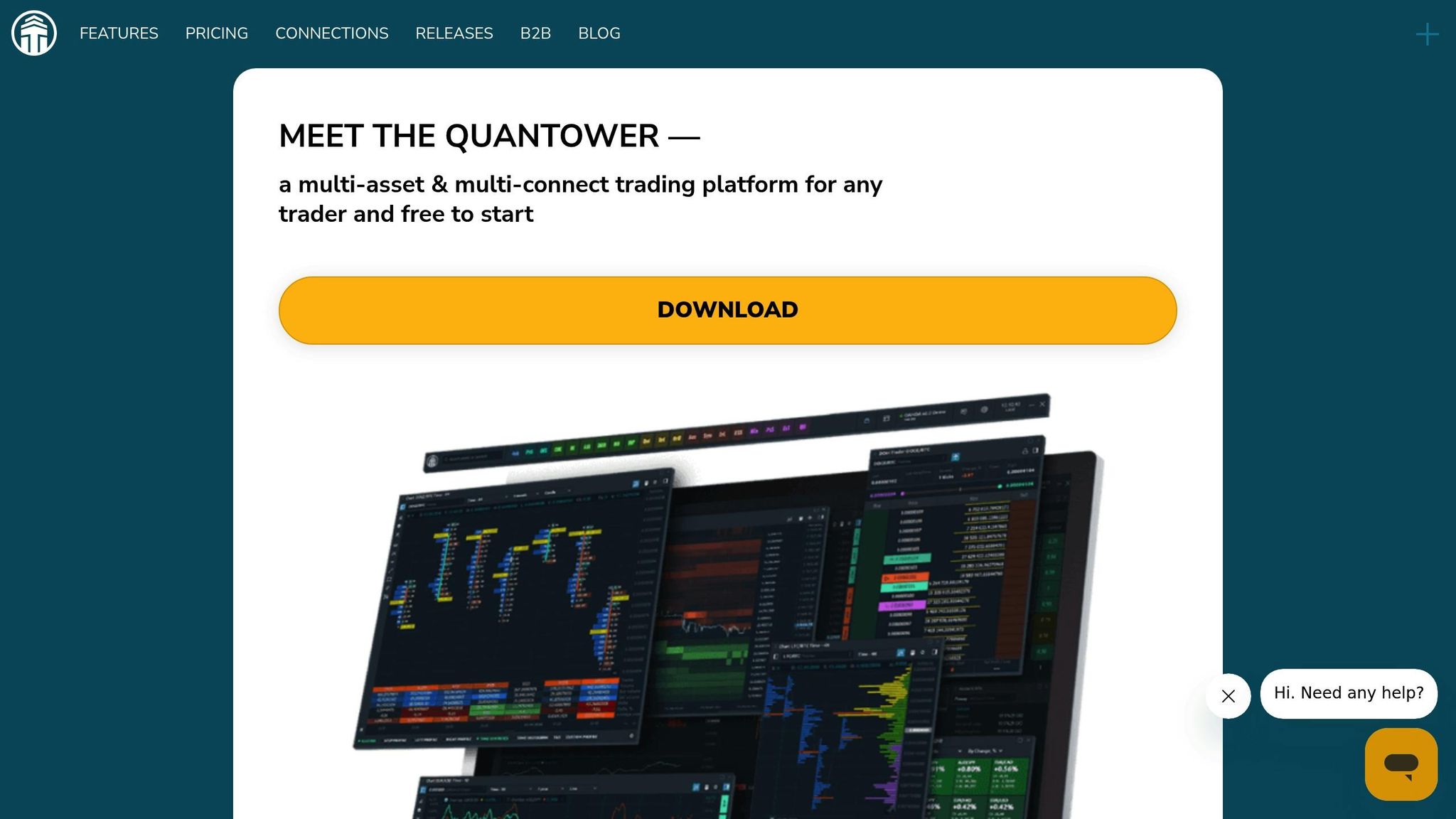
Quantower is a broker-neutral trading platform that connects with over 60 brokers, crypto exchanges, and data feeds. This setup allows traders to analyze and automate their strategies through a single interface without being tied to any specific broker.
Programming Language Support
Quantower enhances its flexibility with an open C# API, enabling users to create custom features like trading automation and algorithmic strategies. Whether you’re designing simple rule-based systems or complex multi-timeframe strategies, the platform provides the tools to bring your ideas to life.
Primary Asset Classes Supported
Quantower supports a wide range of asset classes, including stocks, futures, options, CFDs, cryptocurrencies, ETFs, forex, derivatives, fixed income, and commodities. To complement this, the platform offers more than 40 trading and analytical panels, some of which are tailored to specific asset types, giving traders a robust toolkit for their needs.
Pricing Structure
Quantower offers a tiered subscription model designed to accommodate various trading requirements:
- Free: Includes essential tools for basic analysis
- Starter ($20/month): Adds basic automation features
- Advanced ($50/month): Includes advanced automation and full API access
- Professional ($100/month): Offers backtesting, premium API access, and advanced strategy tools
- Enterprise: Custom pricing for full features and dedicated support
VPS Compatibility and Technical Requirements
To handle real-time data processing and ensure smooth execution of multiple strategies, Quantower requires a high-performance VPS. This ensures reliable uptime and stable connectivity, which are critical for effective trading operations.
5. Sierra Chart
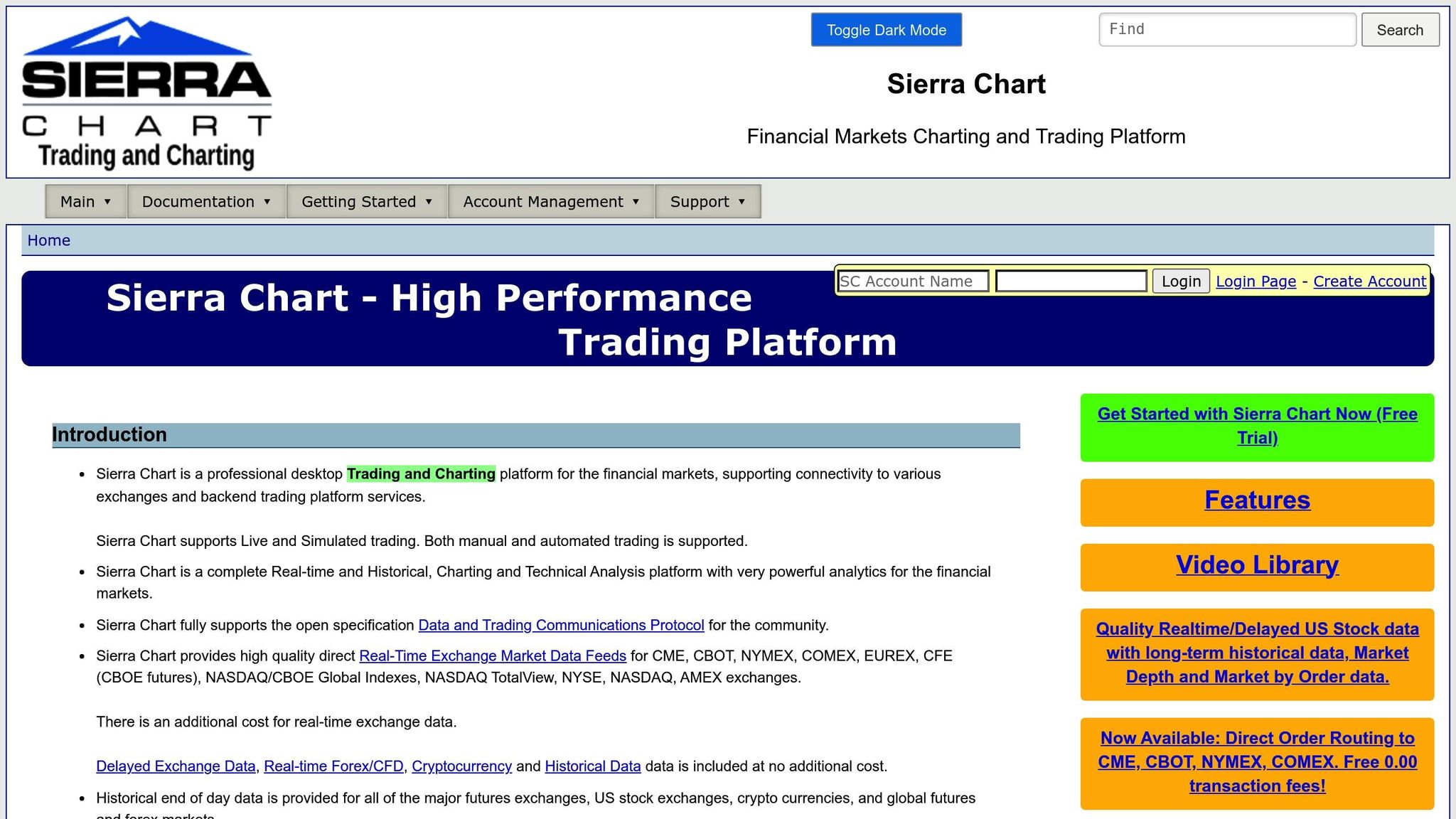
Sierra Chart stands out as a high-performance charting platform, widely appreciated for its reliability and speed. It’s particularly well-regarded among algorithmic traders for its ability to deliver accurate, real-time charting and efficient order management. The platform’s reputation is built on its robust charting tools, quick data processing, and dependable performance.
Although detailed information on its technical specifications, customization features, and pricing might not be readily available, the platform’s track record speaks volumes. Its ability to handle complex trading needs with precision makes it a go-to choice for many algorithmic traders.
Sierra Chart, much like other top-tier platforms, emphasizes the importance of fast and reliable execution – key elements in the world of algorithmic trading.
6. MultiCharts
MultiCharts is a powerful tool for algorithmic trading, offering its proprietary PowerLanguage. This language is designed to resemble TradeStation’s EasyLanguage, making it easier for traders to develop strategies, perform backtesting, and handle broker-agnostic order routing efficiently. One standout feature is its portfolio backtesting, which lets traders test strategies across multiple markets and brokers without hassle. Plus, its multi-broker connectivity ensures smooth execution no matter where you trade. For those familiar with similar systems, MultiCharts offers a seamless transition, maintaining a consistent strategy-building experience.
Up next, we’ll dive into platforms that focus on visualization and order-flow insights.
7. MotiveWave
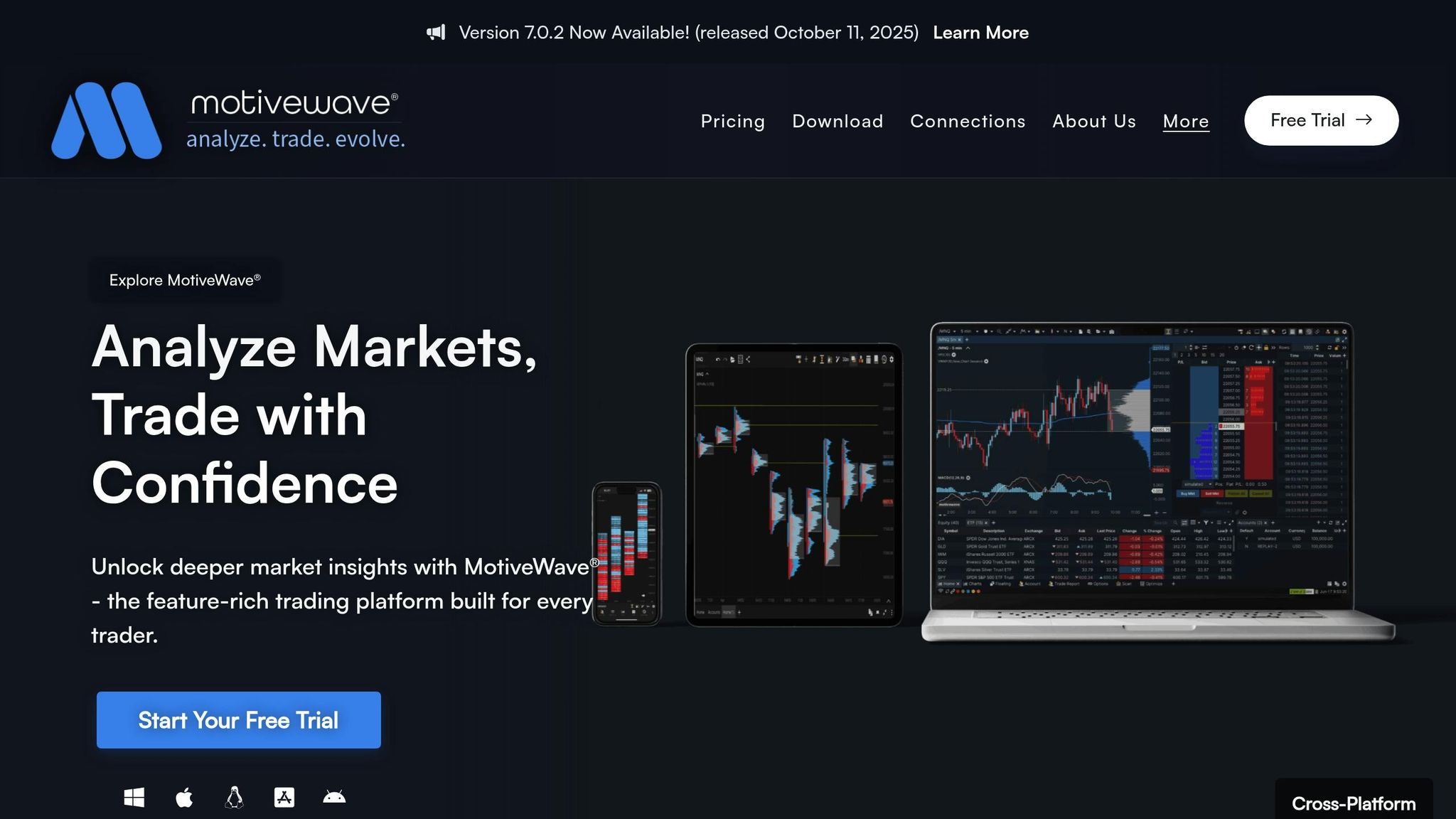
MotiveWave is a powerful trading platform packed with features like advanced strategy design, built-in Elliott Wave analysis, comprehensive studies, and multi-timeframe tools. It supports trading across various markets, including stocks, futures, forex, and options, making it a versatile choice for traders who need in-depth analysis and customization.
With MotiveWave’s extensive capabilities covered, let’s shift focus to AmiBroker and its distinct approach to strategy automation.
8. AmiBroker
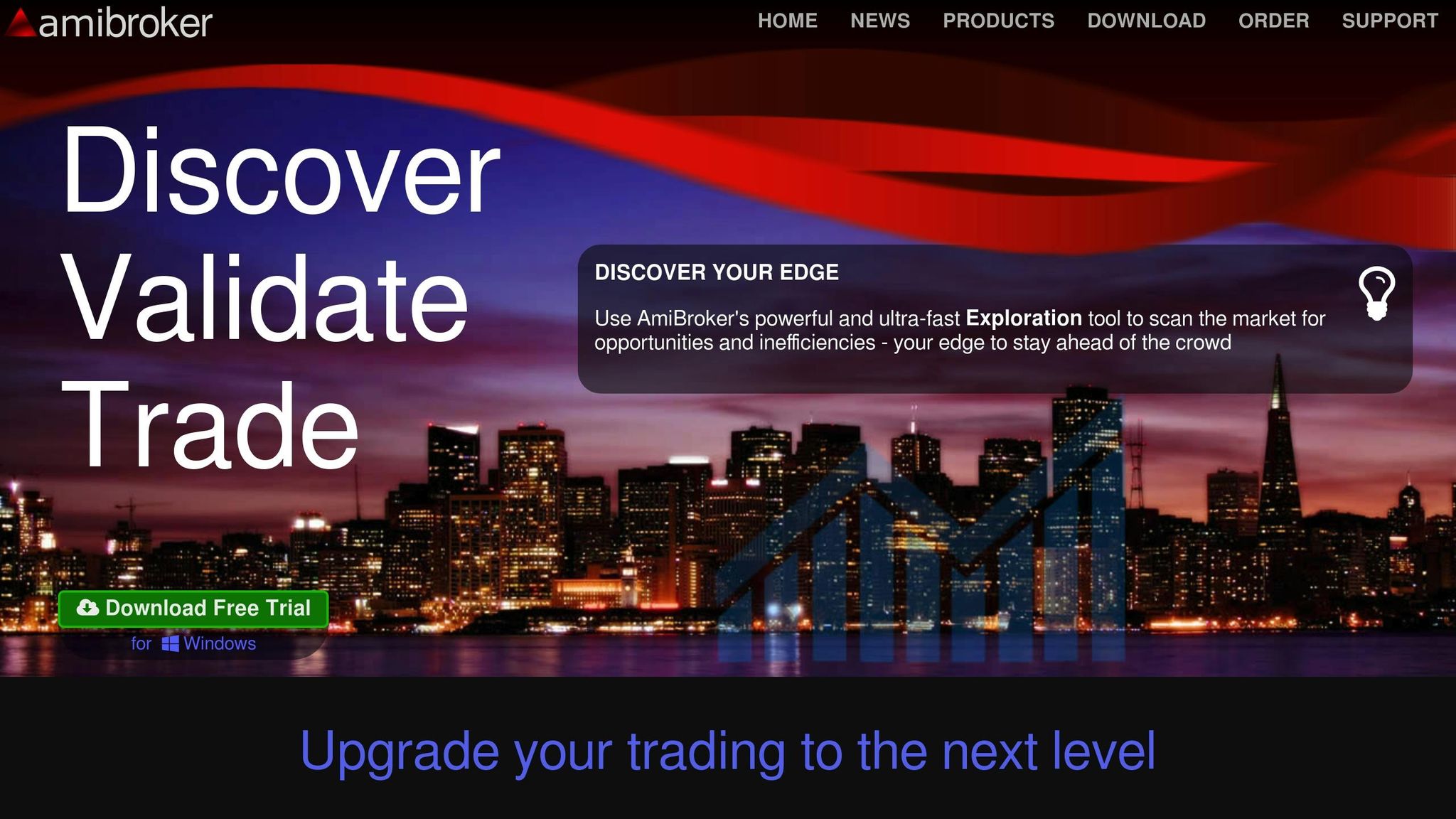
AmiBroker is another advanced platform, particularly suited for those focusing on equities and ETF strategies. It provides tools for efficient strategy development and thorough backtesting, making it a solid choice for traders looking to refine their approach.
Programming Language Support
This platform operates using AFL, or AmiBroker Formula Language. AFL is specifically designed for creating and testing custom trading strategies. It includes a variety of built-in functions tailored for technical analysis and strategy development, giving traders the flexibility to fine-tune their methods.
Pricing Structure
AmiBroker stands out with its one-time purchase model, offering an alternative to the recurring subscription fees common with many other platforms.
9. Tickblaze
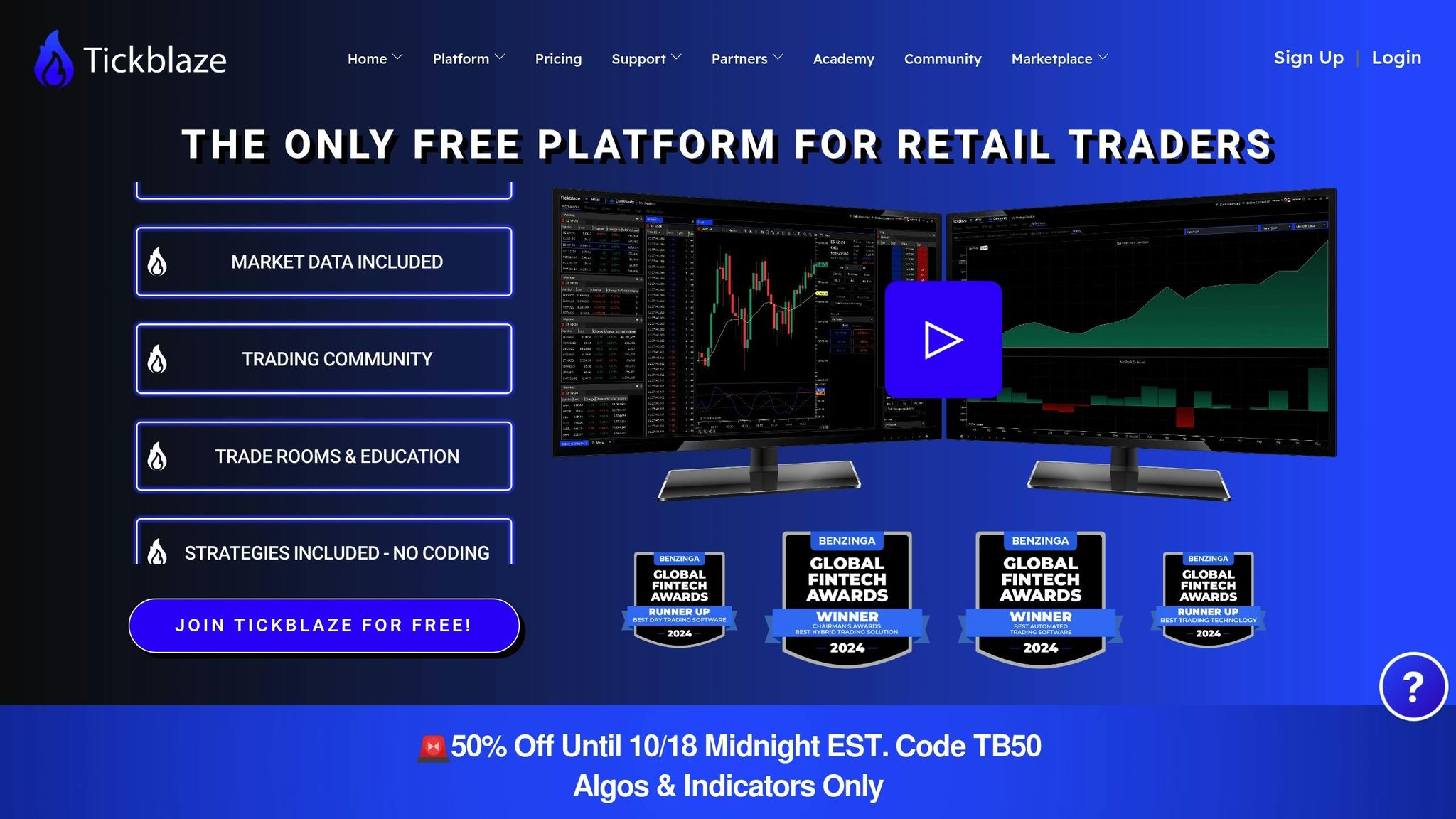
Tickblaze is another trading platform that combines strategy development and execution, though detailed information about its features is somewhat scarce. Here’s what we know about its programming capabilities, asset coverage, and VPS compatibility.
Programming Language Support
Information about the programming languages or scripting environments supported by Tickblaze isn’t readily available. To get the most accurate and up-to-date details, it’s best to consult the official Tickblaze documentation or reach out to their support team.
Primary Asset Classes Supported
Details about the specific asset classes Tickblaze supports remain unclear. If you’re considering this platform, checking their official resources will provide the most reliable guidance on the markets it serves.
VPS Compatibility and Technical Requirements
There’s limited public information about Tickblaze’s compatibility with VPS setups or its system requirements. If you plan to use the platform in a VPS environment, it’s a good idea to confirm these specifications directly with the provider.
As with any trading tool, take the time to thoroughly research and verify all technical and functional aspects through official channels before making any commitments.
10. Bookmap
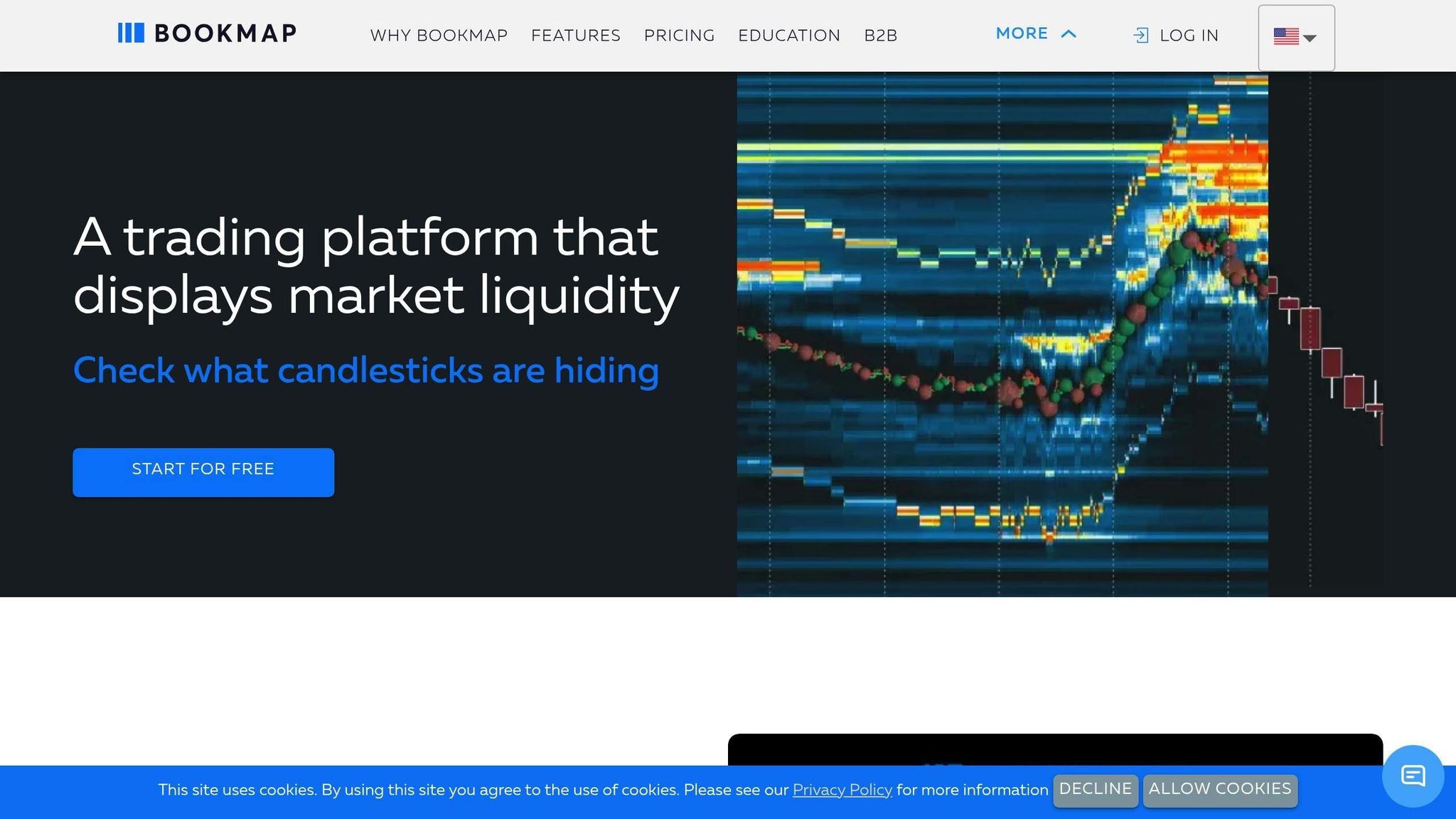
Bookmap is a platform designed for order-flow visualization. It provides real-time heatmaps, depth-of-market views, and liquidity tracking, making it a valuable tool for algorithmic trading.
Programming Language Support
The public documentation doesn’t specify which programming languages can be used for custom automation or plugins. Traders interested in creating custom integrations are advised to reach out to Bookmap’s technical support team for further details.
Its emphasis on visual market analysis sets Bookmap apart from other tools in this space.
11. Trading Technologies (TT) + ADL
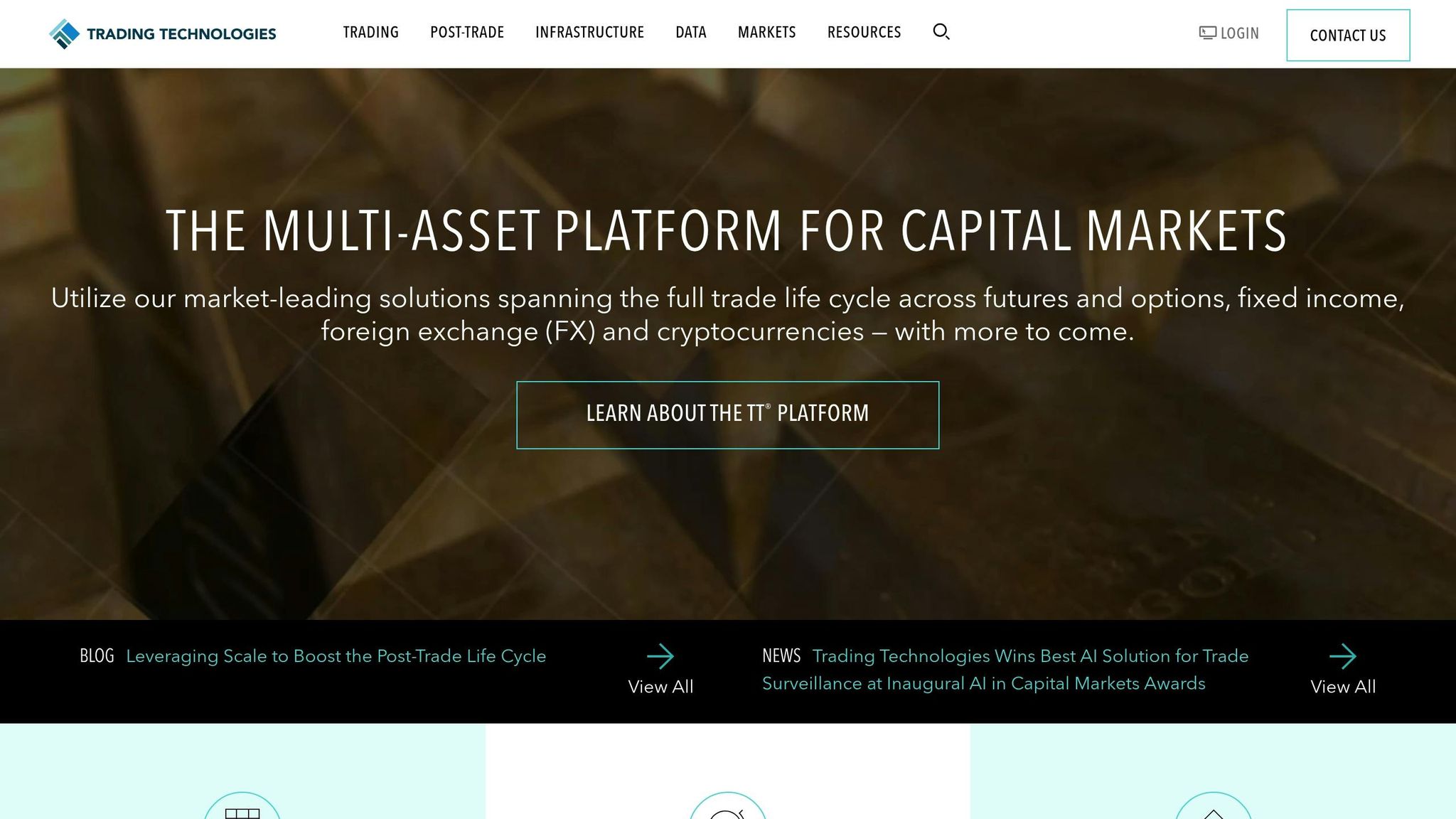
Trading Technologies (TT) offers Algo Design Lab (ADL), a user-friendly, drag-and-drop tool designed for creating algorithmic trading strategies – no coding required. This feature makes it accessible to traders who want to automate their strategies without diving into programming. For more details on supported asset classes, technical specifications, and programming capabilities, check out the official Trading Technologies website. ADL adds to the suite of automation tools available on other platforms mentioned earlier.
12. QuantConnect (Lean Engine)
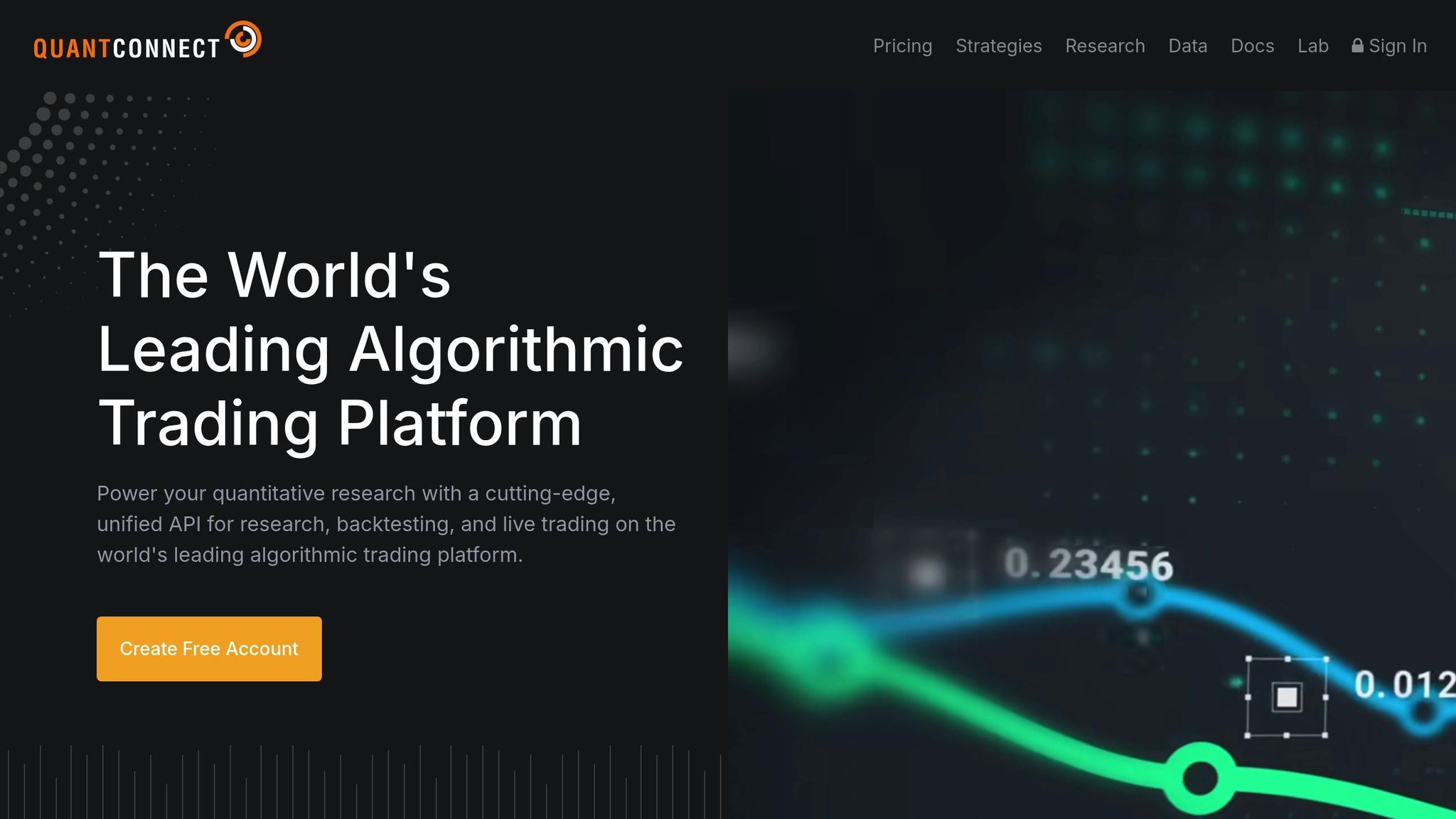
QuantConnect is a cloud-based platform designed for algorithmic trading, offering a powerful combination of institutional-grade data and advanced research tools. Built on the open-source Lean Engine, it provides an all-in-one solution for backtesting, research, and live trading across various asset classes.
One of its standout features is the browser-based development environment, which eliminates the hassle of local installations. Everything – from building and testing strategies to deploying them – happens in the cloud. Plus, users gain access to extensive historical data and real-time market feeds, making it a robust choice for traders.
Programming Language Support
QuantConnect supports both C# and Python, catering to a wide range of programming preferences. Its cloud-based IDE includes helpful tools like IntelliSense, debugging, and version control, ensuring a smooth development experience. Whether you’re drawn to Python’s simplicity or prefer the performance edge of C#, QuantConnect makes it easy to get started with detailed documentation and sample code for both languages.
Primary Asset Classes Supported
QuantConnect covers a diverse array of asset classes, making it a versatile platform for traders:
- US Stocks and ETFs: Historical data dates back to 1998, complete with corporate actions for realistic backtesting.
- Options: Equity options (since 2010) and index options (since 2012) are available, with minute-level resolution.
- Futures: Data spans the most liquid 70 US futures contracts, from tick-level to daily resolution, starting in 2009. Futures options data has been available since 2012.
- Indexes: Includes US cash indexes like NDX, SPX, and VIX, supported with detailed historical data.
- Forex and CFDs: Offers realistic spread modeling and a diverse range of currency pairs and CFD assets for international traders.
- Cryptocurrency: An extensive selection of thousands of trading pairs from six major exchanges, with support for both cash and margin accounts.
On top of this, QuantConnect provides access to alternative data from over 40 vendors. This includes unique datasets like sentiment analysis, satellite imagery, and economic indicators, all of which can enhance strategy development and seamlessly transition from backtesting to live trading.
VPS Compatibility and Technical Requirements
Because QuantConnect operates entirely in the cloud, there’s no need for a VPS. All computations are handled on its servers, so all you need is a reliable internet connection and a modern web browser to access your strategies. This cloud-first approach ensures your algorithms run efficiently on QuantConnect’s infrastructure.
The platform also integrates with several brokerages, simplifying the process of moving from backtesting to live trading. This seamless setup makes QuantConnect a convenient and powerful option for traders looking to execute their strategies with ease.
13. QuantRocket
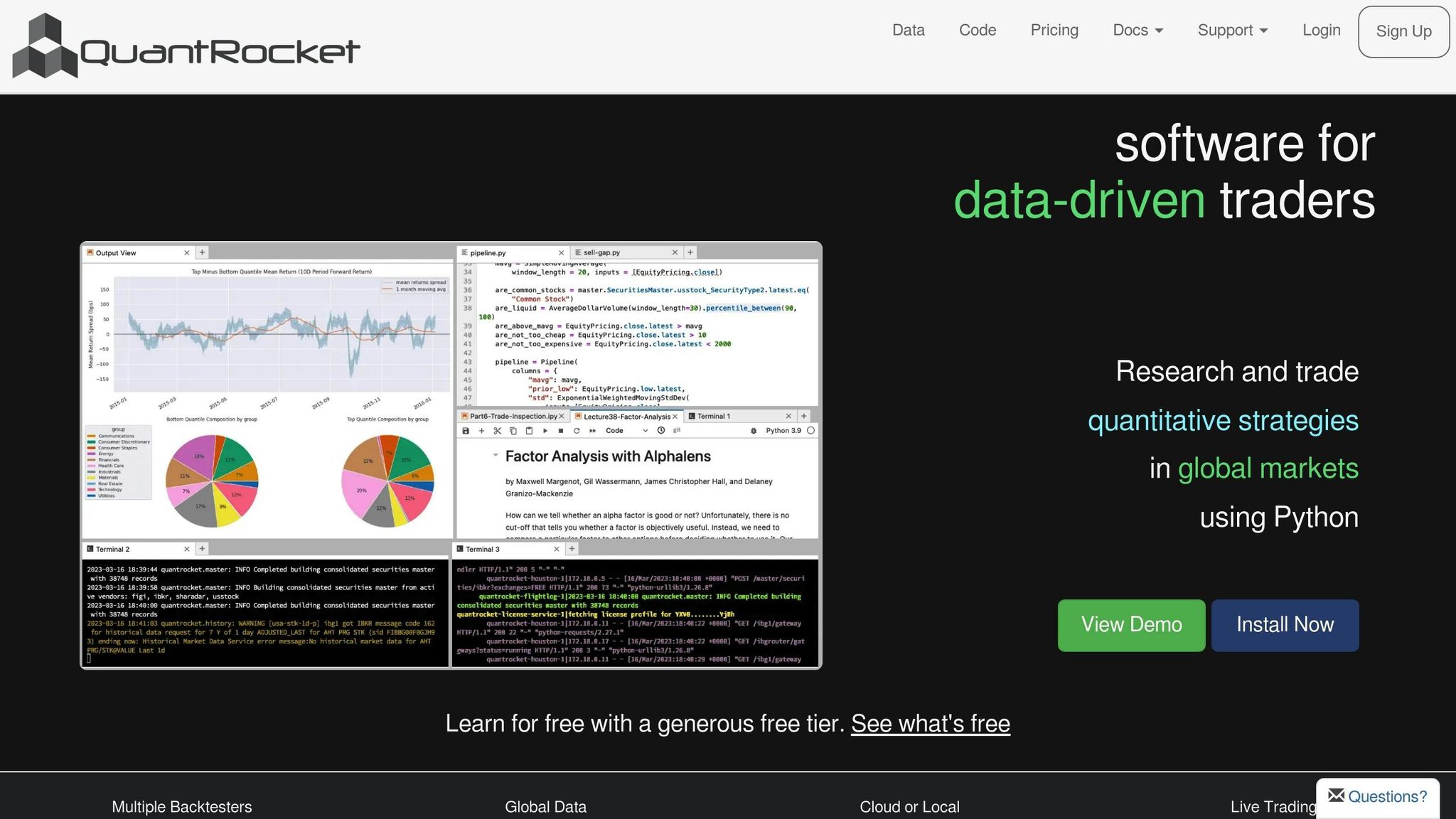
QuantRocket is a code-first platform tailored for Interactive Brokers users who want to build sophisticated algorithmic trading systems. It leverages the open-source LEAN engine and supports both Python and C#, allowing traders to develop and run strategies locally. This flexibility makes it a great choice for those who need control over their trading environment without relying solely on cloud solutions. Let’s dive into its programming capabilities and core features.
Programming Language Support
QuantRocket provides support for Python and C#, offering flexibility in strategy development. Python users can work with Jupyter notebooks and scripts, taking advantage of pre-built modules for data collection, backtesting, and portfolio management. For those who prefer a strongly typed language, C# is available, giving developers another powerful option for building their trading logic.
Primary Asset Classes Supported
QuantRocket connects to all asset classes offered by Interactive Brokers. This includes US and international stocks, options, futures, forex, bonds, and even cryptocurrencies. It’s especially well-suited for handling complex instruments like multi-leg options and futures spreads, making it a solid choice for traders managing diverse and intricate portfolios. This wide market access integrates seamlessly with the platform’s technical infrastructure.
VPS Compatibility and Technical Requirements
QuantRocket is fully compatible with VPS setups, which is ideal for traders seeking optimal performance. To get the best results, deploy it on a dedicated server with sufficient memory, fast storage, and low latency. The software runs on both Windows and Linux, though Linux is often preferred for its stability. Built-in monitoring tools allow you to keep an eye on system performance.
Additionally, QuantRocket integrates smoothly with Interactive Brokers’ TWS or IB Gateway, ensuring reliable and efficient trade execution. This combination of features makes it a robust tool for serious algorithmic traders.
14. AlgoTrader
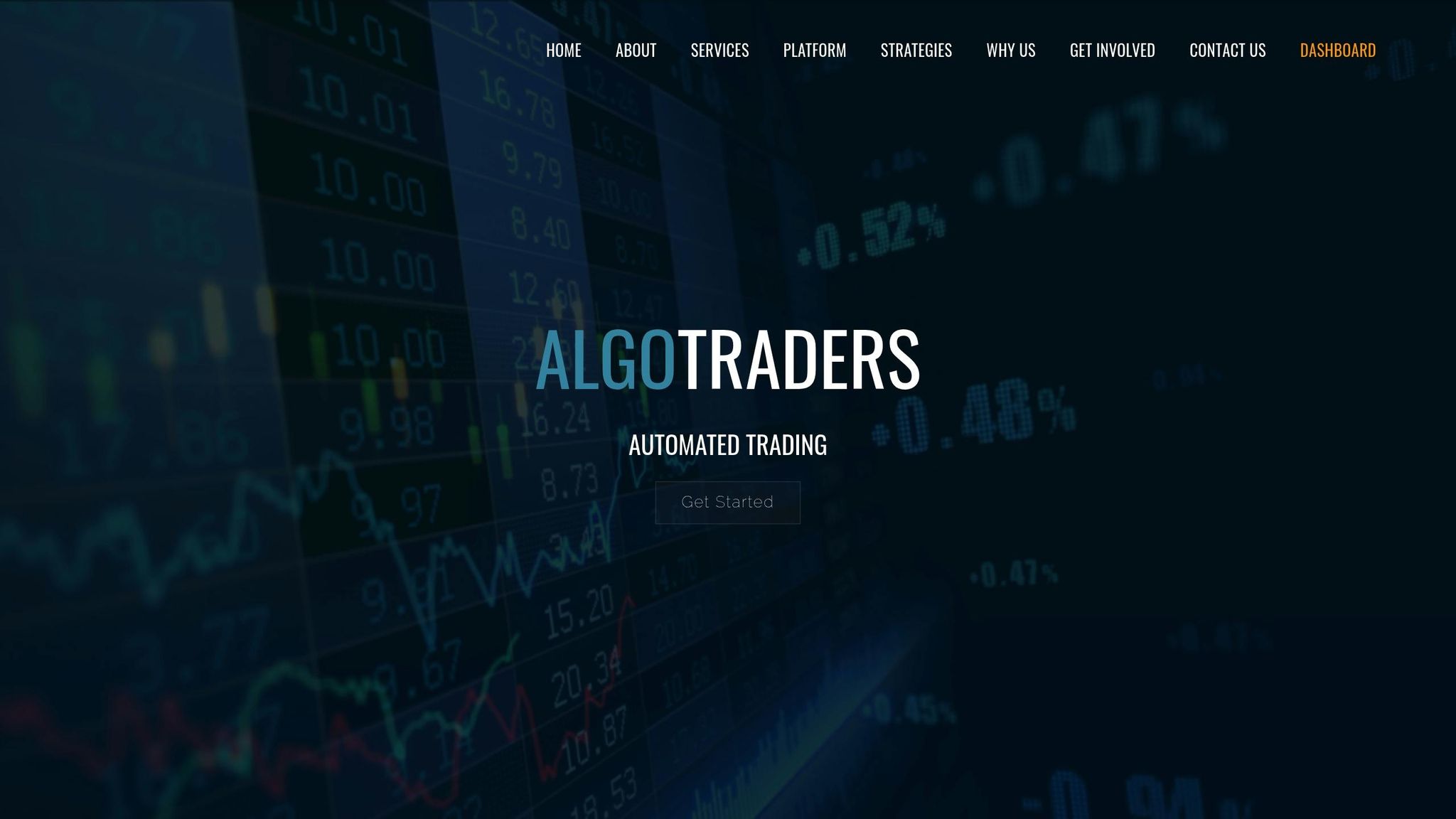
AlgoTrader is designed for the demanding world of institutional algorithmic trading. It caters to hedge funds, proprietary trading firms, and advanced retail traders who need enterprise-level solutions. Built on a Java-based framework, it offers high-frequency trading with ultra-low latency, making it ideal for executing complex automated strategies across various asset classes.
The platform supports both buy-side and sell-side operations, excelling in automated execution, market-making, and features like risk management, event processing, and machine learning. Let’s dive into the key technical elements that make AlgoTrader a standout choice.
Programming Language Support
AlgoTrader is built on a Java-based architecture, which allows for extensive customization. However, working with the platform requires advanced Java programming skills for both setup and ongoing maintenance. While this offers deep integration with existing enterprise systems, it also means a steeper learning curve compared to platforms using simpler scripting languages or visual interfaces.
Primary Asset Classes Supported
AlgoTrader supports trading across traditional assets and cryptocurrencies, enabling strategies such as cross-asset arbitrage and sophisticated portfolio management. Its ability to handle multiple asset types simultaneously makes it especially useful for firms that need to manage diverse instruments within unified trading strategies.
Pricing Structure
The platform follows an enterprise pricing model, with costs tailored to the client’s specific needs and operational scale. Positioned at the higher end of the market, AlgoTrader’s pricing reflects its institutional-grade functionality and features. As a result, it’s best suited for well-funded trading operations rather than individual retail traders.
VPS Compatibility and Technical Requirements
AlgoTrader requires high-performance dedicated servers and expert configuration to fully leverage its Java-based architecture and high-frequency trading capabilities. This ensures the platform operates at its peak performance, supporting the demanding needs of institutional traders.
15. Interactive Brokers API (TWS/IBKR)
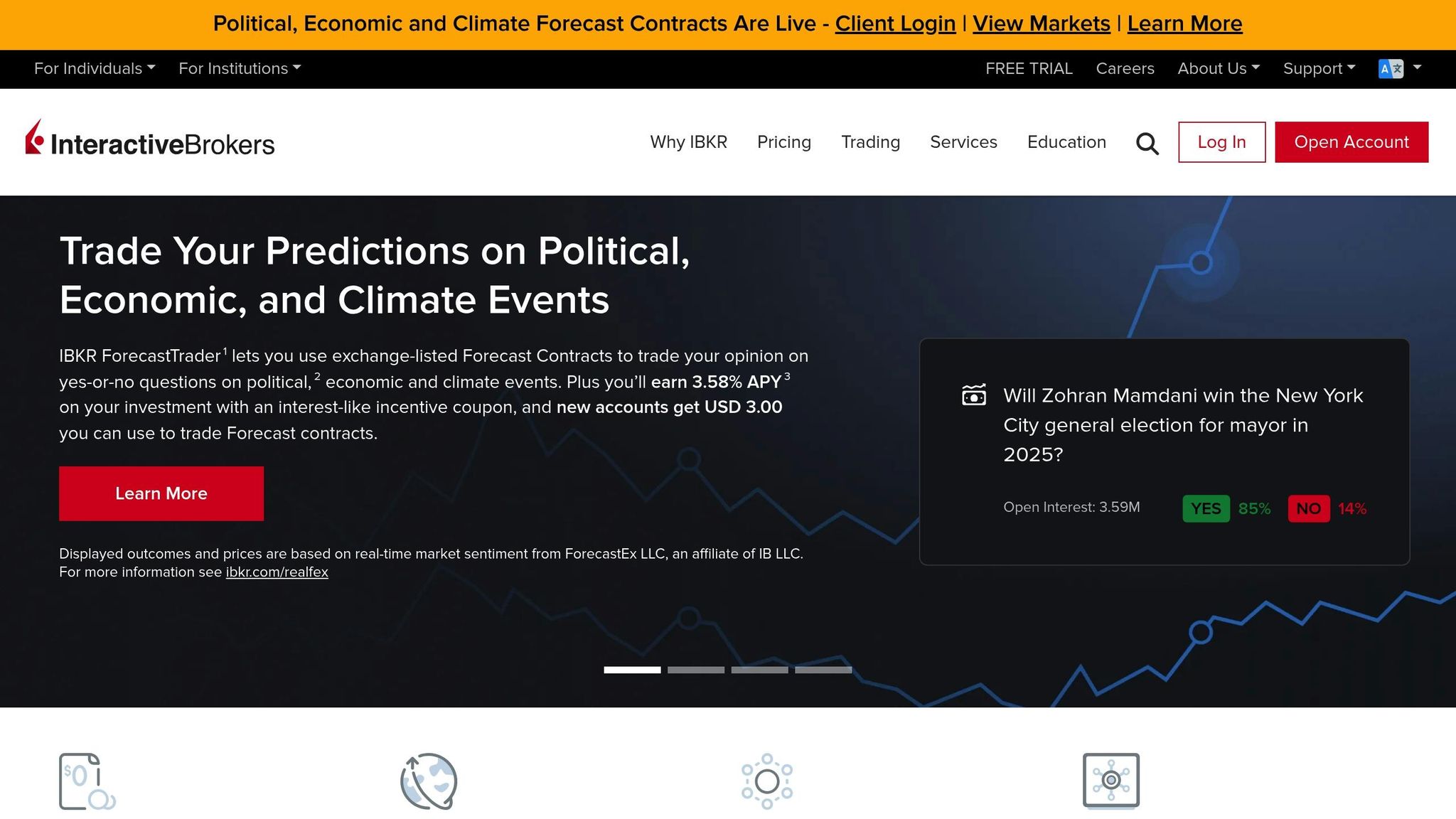
The Interactive Brokers API provides direct market access and complete control over trading strategies. Unlike more user-friendly platforms, this API is designed for developers with advanced programming skills, offering extensive flexibility and institutional-grade execution capabilities.
By connecting through the Trader Workstation (TWS), the API opens up access to global markets with competitive commission rates, making it particularly appealing for high-frequency and high-volume traders.
Programming Language Support
Interactive Brokers API supports multiple programming languages, including Python, Java, and C++. This range allows developers to work within their preferred environments while integrating trading systems into existing enterprise frameworks. However, the API is best suited for experienced developers aiming to create highly tailored and complex algorithmic strategies. While the learning curve can be steep for beginners, the platform provides detailed documentation and sample code to help ease the process.
Primary Asset Classes Supported
The API grants access to a wide range of global exchanges, offering support for stocks, options, futures, forex, bonds, mutual funds, and ETFs. It also includes advanced order types, execution algorithms, and portfolio margin capabilities. Both real-time and historical market data are available, enabling backtesting and live trading. This comprehensive asset coverage makes it possible to design intricate strategies involving multiple asset classes or international diversification.
Pricing Structure
Interactive Brokers employs a tiered commission system, with a minimum account balance requirement of $10,000 for standard accounts. The Trader Workstation (TWS), which serves as the connection point for the API, is available at a cost ranging from $0 to $10 per month, depending on usage.
VPS Compatibility and Technical Requirements
The Interactive Brokers API is well-suited for high-performance VPS setups, making it ideal for continuous automated trading. Designed for institutional-grade execution, its architecture ensures fast and reliable order processing. To maximize performance, it’s recommended to use dedicated resources and low-latency connections to major financial hubs, minimizing the risk of interruptions and ensuring consistent execution speeds.
This powerful API offers a foundation for exploring more specialized trading solutions in the platforms discussed next.
16. Tradovate
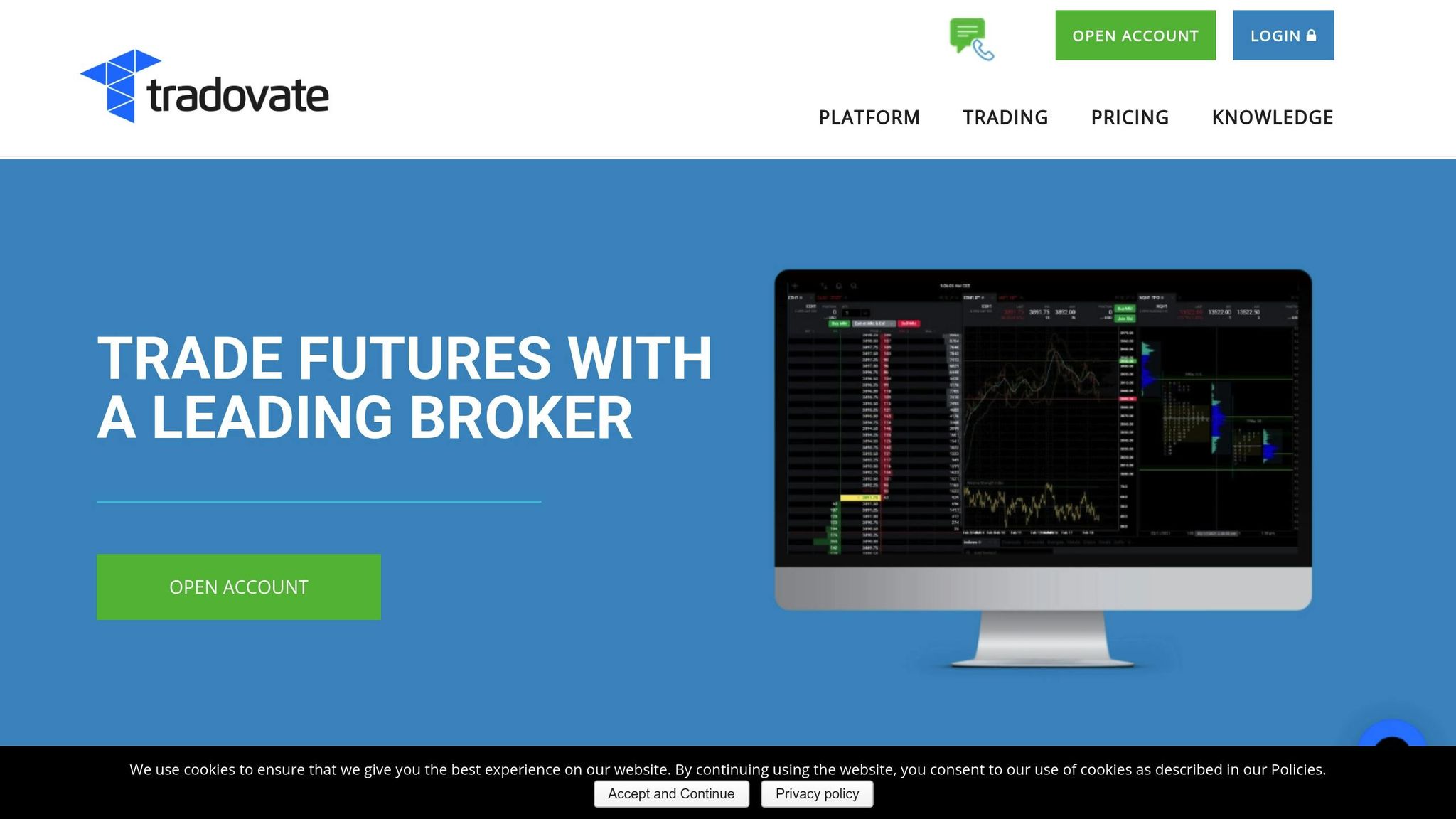
Tradovate is a browser-based trading platform that allows users to manage their accounts from any device with internet access – no need to download or install desktop software. While specific details like API integration, supported programming environments, asset classes, pricing, and technical requirements haven’t been disclosed yet, more information will be shared as it becomes available. Stay tuned for updates!
17. cTrader Automate (cAlgo)
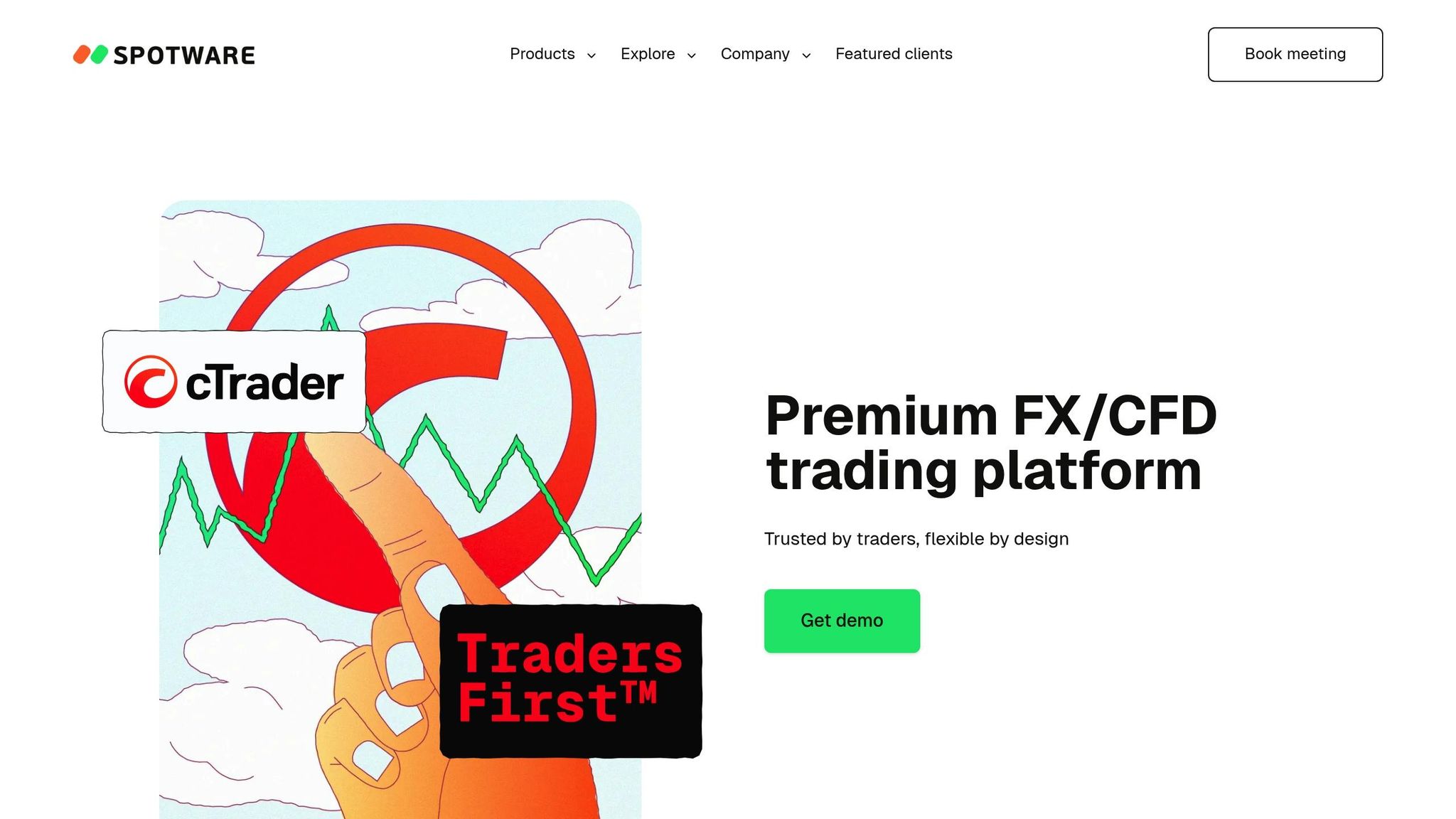
cTrader Automate, also called cAlgo, is an algorithmic trading platform built specifically for forex and CFD traders. It uses C# as its programming language, offering traders the ability to develop automated strategies and trading robots. Thanks to C#’s object-oriented structure, extensive libraries, and smooth .NET integration, the platform appeals to those with a programming background.
Programming Language Support
cTrader Automate exclusively supports C#, making it a natural fit for developers already familiar with the language. This eliminates the need to learn a proprietary scripting language, allowing traders to focus on designing and deploying their strategies efficiently.
Primary Asset Classes Supported
The platform is tailored for forex and CFD trading, making it a popular choice among algorithmic traders in these markets. Many leading brokers, such as IC Markets, Pepperstone, and RoboForex, support cTrader for automated trading. For instance, IC Markets provides FIX API access, which enhances the deployment of C#-based automated systems on the cTrader platform. Additionally, we’ll explore how cTrader Automate works with VPS hosting to ensure smooth and uninterrupted operations.
VPS Compatibility and Technical Requirements
cTrader Automate integrates effortlessly with VPS hosting, enabling traders to keep their bots running around the clock. Hosting your trading bots in low-latency data centers like Equinix NY4 ensures ultra-fast execution and uninterrupted performance.
"Select brokers offering virtual private server connections with low-latency data centers, for example Equinix NY4 servers, to ensure your automated strategies execute continuously without interruption."
18. JForex (Dukascopy)
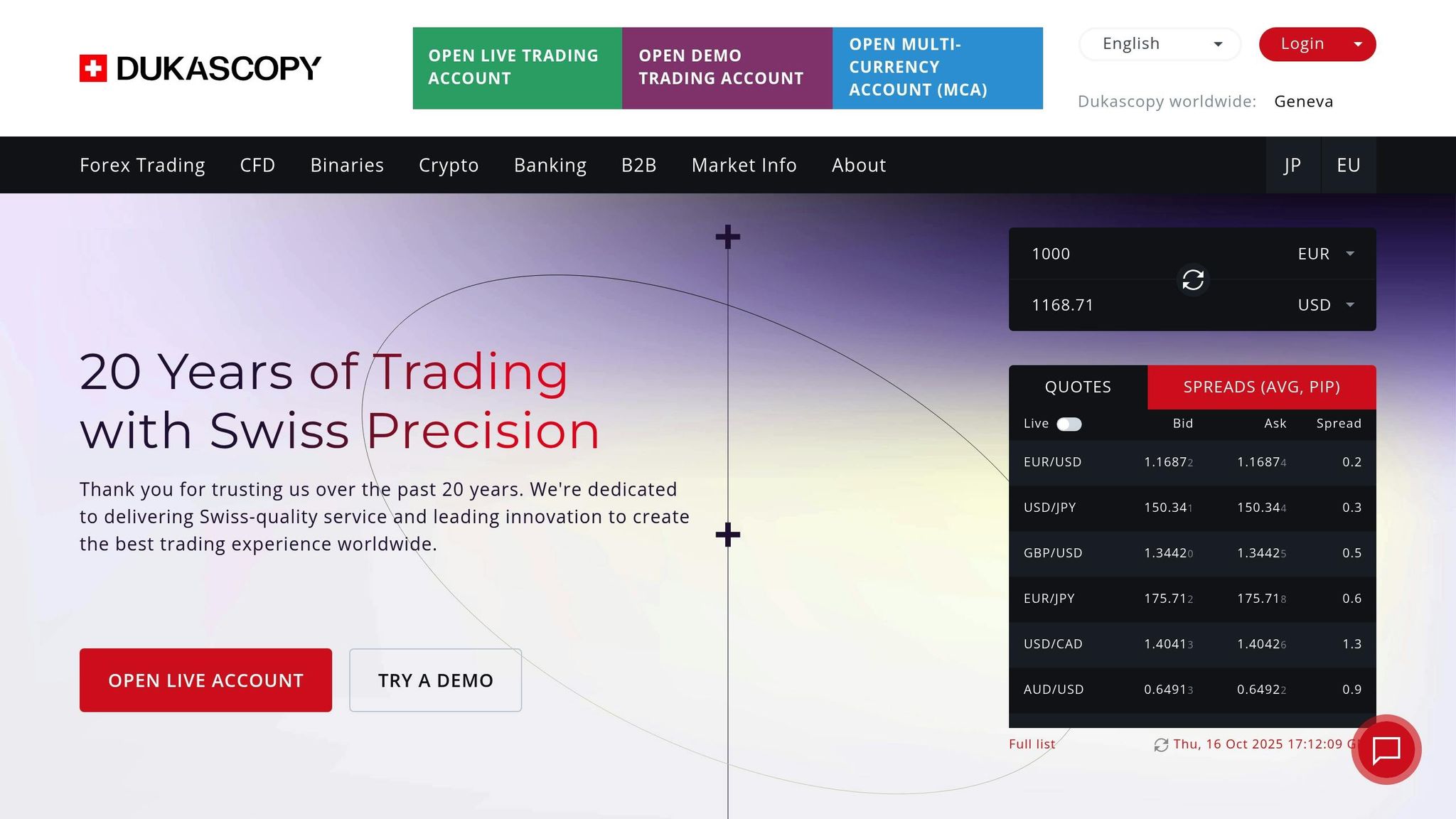
JForex is the in-house algorithmic trading platform developed by Dukascopy Bank, designed specifically for traders who prefer working with Java. The platform features an integrated development environment (IDE) that allows users to write, compile, and test trading strategies using standard Java syntax. It also taps into Java’s powerful object-oriented libraries, offering flexibility and reliability for building complex strategies.
Up next, we’ll dive into platforms that make strategy creation easier with no-code solutions.
19. StrategyQuant X
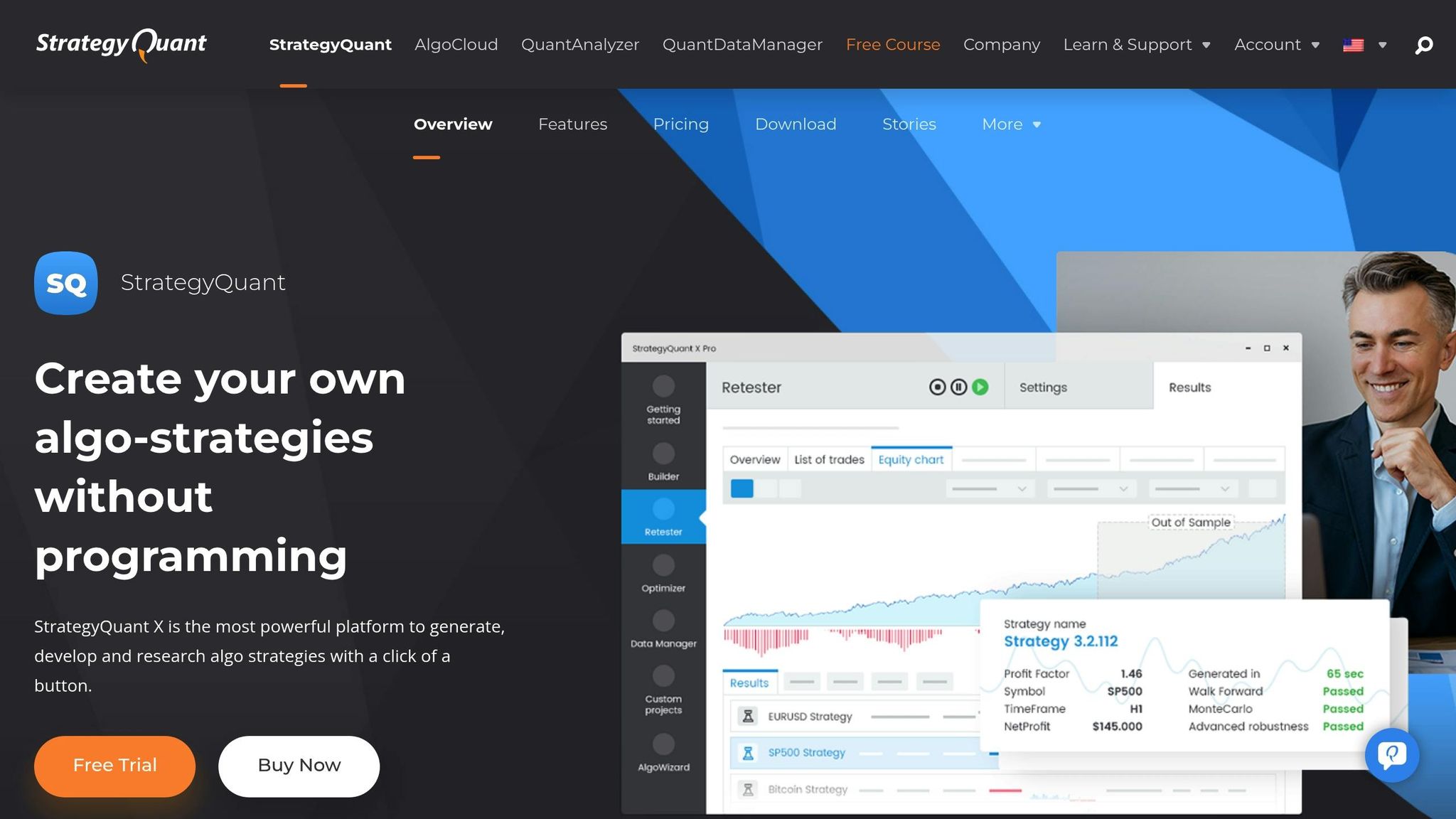
StrategyQuant X makes it easier for traders to create automated trading strategies without needing advanced coding skills. It simplifies the process of turning trading ideas into functional systems by offering tools to generate and backtest strategies using historical market data. This no-code approach aligns well with the automation tools mentioned earlier, focusing on simplicity and efficiency.
For those who value user-friendly platforms but still want powerful strategy-building capabilities, StrategyQuant X provides a strong alternative to more code-heavy options.
Platform Comparison Table
The table below outlines key features across 19 trading platforms, making it easier to evaluate and choose the one that fits your needs.
| Platform | Programming Language | Primary Asset Classes | VPS Compatible | Advanced Backtesting |
|---|---|---|---|---|
| NinjaTrader | C# (NinjaScript) | Futures, Forex, Stocks | Yes | Portfolio-level testing |
| MetaTrader 4/5 | MQL4/MQL5 | Forex, CFDs, Stocks | Yes | Strategy tester with optimization |
| TradeStation | EasyLanguage | Stocks, Options, Futures | Yes | Walk-forward optimization |
| Quantower | C# | Multi-asset | Yes | Multi-timeframe analysis |
| Sierra Chart | C++ (ACSIL) | Futures, Stocks, Forex | Yes | High-frequency backtesting |
| MultiCharts | PowerLanguage | Multi-asset | Yes | Portfolio backtesting |
| MotiveWave | Java | Multi-asset | Yes | Elliott Wave optimization |
| AmiBroker | AFL | Stocks, ETFs | Yes | Ultra-fast portfolio simulations |
| Tickblaze | Visual/Code hybrid | Futures, Stocks | Yes | Real-time strategy testing |
| Bookmap | Java API | Futures, Crypto | Yes | Order flow backtesting |
| Trading Technologies (TT) | ADL (drag-drop) | Futures | Yes | Low-latency testing |
| QuantConnect | C#, Python | Multi-asset | Cloud-based | Institutional-grade backtesting |
| QuantRocket | Python | Multi-asset | Cloud-based | Event-driven pipelines |
| AlgoTrader | Java | Multi-asset | Yes | Risk management testing |
| Interactive Brokers API | Python, Java, C++ | Multi-asset | Yes | Paper trading integration |
| Tradovate | REST/WebSocket | Futures | Yes | Real-time simulation |
| cTrader Automate (cAlgo) | C# | Forex, CFDs | Yes | Tick-level backtesting |
| JForex (Dukascopy) | Java | Forex | Yes | Historical tick data |
| StrategyQuant X | No-code builder | Multi-asset | N/A | Rigorous strategy testing |
This table provides a snapshot of the platforms, but let’s dive deeper into their standout features and differences.
Many platforms support VPS hosting, which is crucial for uninterrupted trading. Interestingly, cloud-native options like QuantConnect and QuantRocket eliminate the need for separate VPS setups by integrating execution directly into their systems.
Programming complexity is another key factor. Platforms like StrategyQuant X and TT’s ADL cater to non-coders with intuitive no-code tools, while others like Sierra Chart (C++) offer deep customization for advanced users. Python-based platforms, such as QuantConnect and QuantRocket, strike a middle ground, combining flexibility with user-friendly scripting.
Asset class specialization also varies significantly. For example, Tradovate and Sierra Chart shine in futures trading, while Interactive Brokers API provides broad market coverage. Forex traders might lean toward platforms like cTrader and JForex, which are tailored for currency trading.
Backtesting capabilities are another area of distinction. AlgoTrader stands out with portfolio-level testing that includes risk management, while platforms like TradeStation and MotiveWave offer advanced features like walk-forward optimization to reduce overfitting. These tools help refine strategies and improve overall trading performance.
Ultimately, each platform has its strengths, whether it’s ease of use, advanced testing tools, or asset class focus. The right choice depends on your trading goals and technical expertise.
Conclusion
Choosing the right platform ultimately comes down to your experience level, the type of assets you trade, and how complex your strategies are. The 19 platforms we’ve explored here range from beginner-friendly tools to advanced, institutional-grade solutions.
For those just starting out, StrategyQuant X offers no-code strategy generation, while MetaTrader 4/5 provides a rich library of Expert Advisors, both requiring little to no coding knowledge.
If you’re an intermediate trader, platforms like NinjaTrader, TradeStation, and MultiCharts strike a balance between usability and functionality. These platforms feature intuitive interfaces, powerful scripting options (like C# or EasyLanguage), and strong backtesting capabilities.
For advanced developers, platforms such as Sierra Chart (C++), QuantConnect (Python/C#), or the Interactive Brokers API allow for fully customized, high-performance solutions.
Your asset focus also plays a key role:
- For futures, consider Tradovate, Sierra Chart, or Trading Technologies.
- For forex, cTrader Automate or JForex are solid choices.
- For stocks and ETFs, platforms like AmiBroker or TradeStation stand out.
If you prefer cloud-based platforms, QuantConnect and QuantRocket eliminate the need for VPS setups, while desktop systems will require reliable VPS hosting to ensure smooth 24/7 execution – especially as your strategies grow in scale.
The best approach? Start simple and build up gradually. Begin with paper trading or small position sizes to test your strategies in real-world conditions. Remember, no amount of backtesting fully replaces the lessons learned from live market experience.
FAQs
What should I consider when selecting an algorithmic trading platform to match my trading goals and experience?
When choosing an algorithmic trading platform, it’s important to match its features with your trading goals and skill level. Look for platforms that offer tools to build, test, and automate trading strategies, along with access to real-time market data. For beginners, ease of use should be a priority – an intuitive interface can make a big difference. More experienced traders, on the other hand, might prefer platforms with advanced customization options and greater flexibility.
Make sure the platform supports the specific financial instruments you trade, whether that’s stocks, forex, futures, or cryptocurrencies. Equally critical are factors like reliability, strong security measures, and responsive customer support to ensure a seamless trading experience. Lastly, take a close look at the platform’s pricing – whether it’s a subscription fee or transaction-based costs – and confirm it aligns with your budget.
What are the typical costs of algorithmic trading platforms, and how do pricing structures vary for advanced features?
The price of algorithmic trading platforms can range significantly, depending on the tools and features they offer. Many platforms use tiered pricing structures, with basic plans typically costing $0 to $100 per month, while premium plans – offering advanced capabilities like institutional-grade data or low-latency execution – can exceed $500 per month. Additionally, some platforms may charge one-time license fees or fees tied to trading volume.
If you’re looking for features such as custom scripting, backtesting, or automation, be prepared for higher costs, especially with platforms designed for professional or enterprise-level traders. To make an informed decision, it’s a good idea to check the platform’s pricing page or reach out to their support team for a detailed cost breakdown that matches your trading goals and budget.
What are the advantages of using a cloud-based algorithmic trading platform over one that requires VPS hosting?
Cloud-based algorithmic trading platforms bring some clear perks compared to VPS-hosted setups. One standout benefit is scalability – you can easily adjust resources to match your trading volume without worrying about upgrading physical hardware. This flexibility ensures your system can handle spikes in activity smoothly. Plus, cloud platforms often handle updates and maintenance automatically, keeping everything running efficiently with minimal interruptions.
Another big plus is accessibility. With just an internet connection, you can monitor and tweak your trading strategies from virtually anywhere. On top of that, these platforms typically come with built-in redundancy and failover mechanisms, offering a level of reliability that VPS setups often require manual effort to achieve.








